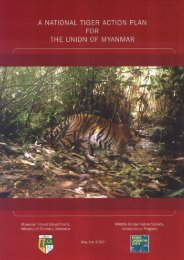Thailand Tiger Action Plan - Global Tiger Initiative
Thailand Tiger Action Plan - Global Tiger Initiative
Thailand Tiger Action Plan - Global Tiger Initiative
Create successful ePaper yourself
Turn your PDF publications into a flip-book with our unique Google optimized e-Paper software.
Threats to the <strong>Tiger</strong>The most significant challenges to tiger survival in <strong>Thailand</strong> are the sameas those faced throughout the species’ range: habitat degradation andpoaching of prey and tigers. Poaching of tiger prey is primarily driven byan active commercial trade in wildlife to satisfy growing demands byrestaurants. Direct poaching of tigers is expected to increase in areaswhere tigers exist and driven by the traditional medicine market and ritualdemands for amulets.The gradual conversion of forest cover loss over this past century hasresulted in fragmented forest habitat in <strong>Thailand</strong> that has created isolatedtiger populations. Many of these populations are too small to have longtermviability unless current habitat is protected, the amount of habitatincreased, and habitat fragments connected by corridors (Smith et al.1998; Wikramanayake et al. 1998).Prey depletion is another important threat to tigers (Karanth & Sunquist1995). Poaching of prey species is intensive in many protected areas in<strong>Thailand</strong>. In large portions of many of the protected areas where tigers stilloccur, there is little or no sign of prey species. Reversing the decline ofprey populations within otherwise suitable habitat is crucial not only for thetiger, but also for the ecosystems in which it occurs.In the early 1990s, tiger poaching increased dramatically throughout thetiger’s range. In 2005 the world was shocked with the report that tigerswere extinct from Sariska National Park, one of India’s prime tigerreserves. This story brought the problem to the attention of the globalpublic, but the response did not match the growing threat and tigerpopulations continued to decline. Only about a year later, another ofIndia’s premier tiger reserves, Panha National Park, also reported thattigers had been wiped out. Since then, reports of similar trends havebecome all too common.In <strong>Thailand</strong> in March 2010, at least 3 tigers were found dead frompoisoning in the interior of Huai Kha Khaeng Wildlife Sanctuary, the site of<strong>Thailand</strong>’s highest tiger densities in <strong>Thailand</strong>. While the poachers wereconfronted by a research team at the scene of the crime, they were able toescape arrest and take with them various parts of a poisoned tiger.The prior examples have proved that tigers are a protection dependentspecies. Protection at site and landscape levels is the most immediateaction to save and recover tigers and their prey. Recent scientific findingsreveal that existing protection quality in many protected areas in <strong>Thailand</strong>is not enough to save them. The inefficiency in patrols and lack of lawenforcement monitoring system is considered a serious threat to tigers in<strong>Thailand</strong>. The system needs to be modernized and the support to parkrangers needs significant improvement.Several other significant factors hinder the survival of the tiger. One is alack of commitment to using rigorous techniques for estimation of manytiger population parameters. Without baseline data on tiger populationsthere is no way to measure the success of management efforts. Another
















